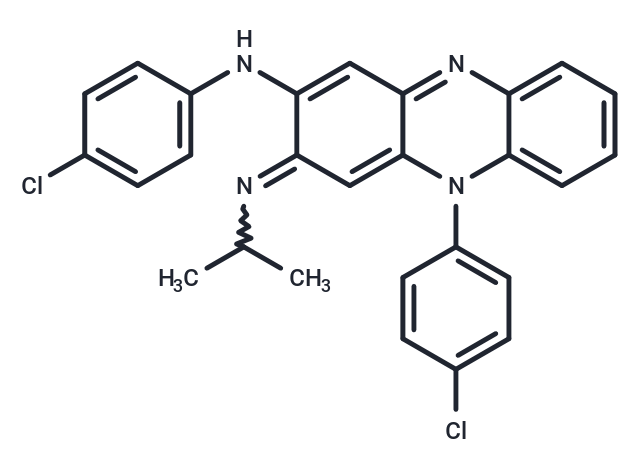Shopping Cart
Remove All Your shopping cart is currently empty
Your shopping cart is currently empty
Clofazimine (NSC-141046) is a phenazine dye with anti-mycobacterial and anti-inflammatory activities. Clofazimine has a slow bactericidal effect on Mycobacterium leprae and is active against various other Mycobacteria.

| Pack Size | Price | USA Warehouse | Global Warehouse | Quantity |
|---|---|---|---|---|
| 500 mg | $30 | - | In Stock |
| Description | Clofazimine (NSC-141046) is a phenazine dye with anti-mycobacterial and anti-inflammatory activities. Clofazimine has a slow bactericidal effect on Mycobacterium leprae and is active against various other Mycobacteria. |
| In vitro | Administered bi-daily at 500 μg, Clofazimine accumulates at the highest concentrations in the spleen and liver, while significantly reduced levels are observed in the lungs. A dosage of 20 mg/kg of Clofazimine can prevent death by significantly decreasing the colony-forming unit (CFU) count in the lungs and spleen of C57BL/6 mice infected with the tuberculosis bacillus Mycobacterium tuberculosis H37Rv. The same dosage effectively lowers bacterial numbers in the liver, spleen, and lungs of C57BL/6 mice infected with the Mycobacterium avium strain TMC724. Moreover, 50 mg/kg of Liposomal Clofazimine in acute infection reduces CFUs in the spleen, liver, and lungs of mice harboring the Erdman strain of tuberculosis, exhibiting dose-dependency. |
| In vivo | At a concentration of 1 μg/mL, Clofazimine inhibits the activity of J774A.1 macrophages in a dose-dependent manner. The compound targets neutrophils, activating phospholipase A2 which, in turn, increases the release of lysophosphatidylcholine and arachidonic acid from the neutrophil membrane. In macrophages, Clofazimine stabilizes lysosomal membranes and impedes the metabolism of Mycobacterium leprae within murine peritoneal macrophages. Additionally, Clofazimine exhibits a 90% inhibition rate on 20 strains of Mycobacterium tuberculosis with minimum inhibitory concentrations (MICs) of less than 1.0 μg/mL. It also suppresses the mitogen-induced proliferation of peripheral blood mononuclear cells. |
| Synonyms | NSC-141046 |
| Molecular Weight | 473.4 |
| Formula | C27H22Cl2N4 |
| Cas No. | 2030-63-9 |
| Smiles | N(C(C)C)=C1C=C2N(C=3C(N=C2C=C1NC4=CC=C(Cl)C=C4)=CC=CC3)C5=CC=C(Cl)C=C5 |
| Relative Density. | 1.29g/cm3 |
| Storage | keep away from direct sunlight | Powder: -20°C for 3 years | In solvent: -80°C for 1 year | Shipping with blue ice/Shipping at ambient temperature. | |||||||||||||||
| Solubility Information | H2O: < 1 mg/mL (insoluble or slightly soluble) Ethanol: < 1 mg/mL (insoluble or slightly soluble) DMSO: 2.64 mg/mL (5.58 mM), Sonication is recommended. | |||||||||||||||
Solution Preparation Table | ||||||||||||||||
DMSO
| ||||||||||||||||
| Size | Quantity | Unit Price | Amount | Operation |
|---|

Copyright © 2015-2025 TargetMol Chemicals Inc. All Rights Reserved.